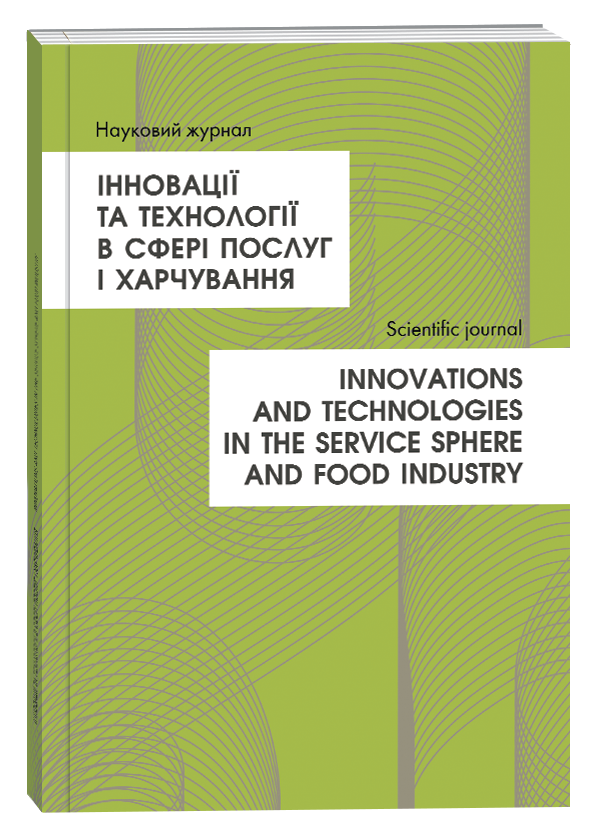APPLICATION OF MOLECULAR CUISINE TECHNOLOGIES AS A FACTOR OF RESTAURANT SERVICE GROWTH
Abstract
Molecular cuisine is a relatively young and complex direction in the culinary arts. The basis for the appearance of molecular cuisine was the emergence of molecular gastronomy, a scientific discipline that involves the study and understanding of the mechanisms of interaction between products during cooking, using the equipment of chemical laboratories. The preparation of molecular cuisine takes place according to certain techniques, with the use of special equipment and the addition of special ingredients. All this allows you to change the appearance of dishes, their tastes and make the presentation of the dish enchanting. Thanks to the application of techniques such as spherification, gel formation, dehydration, foaming, gassing, quick freezing, thickening, sous vide or vacuum, gluing, ordinary dishes get an unusual appearance and taste, such as herring ice cream, or an apple with the taste of meat. Cooperation between famous scientists and chefs in the field of molecular cuisine contributes to its further development and the emergence of new cooking techniques. The main difference between molecular cuisine restaurants and standard restaurants is serving more dishes in small portions with an artistic presentation in an unusual form for standard restaurants. The process of food preparation can take place in front of the restaurant guests. Initially, molecular cuisine gained popularity in the countries of Western Europe and North America, and later became widespread in other countries of the world. Despite the wide distribution of molecular food in the world, in Ukraine molecular cuisine is presented very limited, and is at the initial stage of its development. The use of a scientific approach in food preparation allows you to create not only unusual tastes and an amazing appearance of dishes, but also makes them useful for human health. Compared to dishes that are prepared by the conventional method, molecular cuisine dishes retain most of the useful and nutritious substances, vitamins and proteins, all of which make them healthier food. Today in the world, modern molecular cuisine shows a tendency towards further progress and popularization.
References
Aguilera J. (2005). Why food microstructure? Journal of Food Engineering, Vol. 67, pp. 3-11.
D`Angelo G., Hansen H.N. and Hart A.J. (2016). Molecular gastronomy meets 3D printing: Layered construction via reverse spherification. 3D Printing ans Additive Manufacturing, vol. 3(3), pp. 152-159.
Edward-Stuart R. And Valverde J. (2008). Food quality, an issue of molecule-based science. European Food Research and Technology, vol. 227, pp. 965-967.
Halford B. (2014). The Science of Spherification. Chemical & Engineering News, vol. 92(42), pp. 35-36.
Jeong K., Hyeonbin O., Shin S.Y. (2018). Effects of sous-vide method at different temperatures, times and vacuum degrees on the quality, structural, and microbiological properties of pork ham. Meat science, no. 143, pp. 1-7.
NYC`s Most Appetizing Molecular Gastronomy Restaurants. Available at: https://medium.com/@UpOutNYC/nycs-most-appetizing-molecular-gastronomy-restaurants-21171f2ea59c
Risbo J., Mouritsen O.G. (2013). Culinary science in Denmark: molecular gastronomy and beyond. Journal of Culinary Science & Technology, vol. 11 (2), pp. 111-130.
Sivakumaran K., Prabodhani W. (2018). An overview of the applications molecular gastronomy in food industry. Int. J. Food Sci. Nutr, vol. 3, pp. 35-40.
The Top 5 Molecular Gastronomy Restaurants You Need to Visit Around the World. Available at: https://skyticket.com/guide/22875
Van der Linden E., McClements D. and Ubblink J. (2008). Molecular gastronomy: a food fad or an interface for science-based cooking? Food Biophysics, vol. 3, pp. 246-254.



